



BC Opioid Overdose Crisis Pacific AIDS Network Annual Meeting October 30, 2018 Miranda Compton Overdose Emergency Response Centre
BC Overdose Deaths 1992 – August 31, 2018
BC Overdose Deaths
BC Overdose Deaths
People who have died from overdose due to illicit drugs, BC 180 160 140 120 100 Number of Deaths 80 60 40 OERC Established Declaration of 20 provincial emergency 0 Jan Feb Mar Apr May Jun Jul Aug Sept Oct Nov Dec Jan Feb Mar Apr May Jun Jul Aug Sept Oct Nov Dec Jan Feb Mar Apr May Jun Jul Aug Sept Oct Nov Dec Jan Feb Mar Apr MayJune July Aug 2015 2016 2017 2018 Illicit drug overdose deaths in BC: Jan 1, 2015 to Aug 31, 2018. BC Coroners Service.
Coroner’s analysis (Jan-June 2018) Illicit drug overdose deaths in BC: Jan 1, 2018 to August 31, 2018. BC Coroners Service (Fentanyl detection available Jan-Jun 2018)
Modelling: Deaths Averted Take home naloxone, overdose prevention sites, opioid agonist therapy Model estimates would have seen 2.5 times more deaths if interventions not in place Figure provided by Michael Irvine, BCCDC/UBC. Preliminary results and subject to change.
BC Cascade of Care for People with Opioid Use Disorder (as of November 30, 2017) 55,469 people *preliminary results Only 10% retained on treatment
Patients on Opioid Agonist Therapy, BC 21,170 Data provided to BCCDC by Pharmaceutical Services Division, Ministry of Health
Provincial Context Overdose Emergency Response Centre • Mandate to reduce opioid overdose deaths • Includes Opioid Agonist Therapy • Dedicated funding provided to each health authority Provincial Mental Health and Addictions Plan • Responsibility of new Ministry to set strategy • Planning underway; includes health authorities Risk Factors for Addiction and Mental Illness • Housing, poverty, early childhood development, Aboriginal reconciliation • Broader government approach
Comprehensive Package of Interventions Health Sector Interventions Interventions in the health sector aimed at decreasing the impact of overdose in BC Overdose Acute Treatment Naloxone Prevention Overdose and Recovery Services Risk Case Management Social Stabilization Peer empowerment and employment Cultural safety and humility Addressing stigma, discrimination, human rights Enabling strategies that advance the delivery and success of health sector interventions
Community Action Teams • Announced Feb. 1 in Abbotsford • 20 communities with most urgent need per data • Up to $100,000 in kick-start grant funding available per community • Membership: Health authority, municipality, first nations, first responders, public safety, community agencies, divisions of family practice, lived experience/family groups
Community Action Teams • Vancouver • Victoria • Richmond • Campbell River • Powell River • Nanaimo • Surrey • Duncan • Langley • Port Alberni • Abbotsford • Kelowna • Maple Ridge • Kamloops • Chilliwack • Vernon • Burnaby • Prince George • New Westminster • Fort St. John
Health System Priorities: Naloxone Naloxone – Toward the Heart ( ) has ensured comprehensive low barrier access to Naloxone and continued expansion of access, training, supplies – Diversity of modes of distribution via housing sites, clinics, community services, pharmacies, peer networks Community Innovations: Peer-led training & distribution Facility Overdose Response Box Kit distribution via paramedics (pilot), pharmacies
Health System Priorities: Overdose Prevention • Supervised Consumption Sites • Overdose Prevention Sites • Safer using spaces in housing • Incorporating into RN services in primary care sites • increased access to OD prevention Services : housing, mobile, tech applications • Innovations to provide access to safer drug supply: drug checking, embedded OAT within programs Community Innovations : Drug-checking via youth centres, festivals, events, outreach Mobile overdose app – for using alone at home
Health System Priorities: Overdose Follow-Up – Build capacity across community for proactive follow-up – Link high risk individuals to care via outreach, mobile services Support Navigation – Leverage moments of connection across service system in to accessing appropriate – Pilot Project: 3 communities for police referral to health system OAT services – Build on Innovative ideas Overdose • Police (Situation Tables, Abbotsford Project Angel - After-hours connections) prevention Fire (Surrey Fire: 2 nd Responder Initiative) education • • Paramedic – Connection Clinic warm handover to system of care • Emergency Department: Automatic referral for follow-up Community Innovation : VCH Overdose Outreach Team 91% clients contacted <3 days from referral
Health System Priorities: Treatment & Recovery • Ensuring availability of evidence-based treatment options - Access to Methadone, Suboxone TM , oral morphine, injectable hydromorphone - Licensed, regulated, residential treatment system monitored for quality - Continuity of care for those leaving Corrections Community Innovations: Rapid Access Clinics PHSA Corrections Transitions Team iOAT
Overdose Emergency Key Initiatives • 20 $100k Community Action Team Grants • 27 additional Community Innovation Grants of up to $75k (23 regional projects, 4 provincial projects) • Industry Roundtable on overdose – follow-up pilot projects • Health Canada funded Hope Initiatives – Resources to expand capacity for pro-active follow-up – Treatment capacity building • Safer supply pilot initiatives (iOAT expansion, oral dilaudid) • Community Innovation Funding • Human Rights project
Thank you! OERC@gov.bc.ca Miranda.compton@vch.ca
Recommend
More recommend